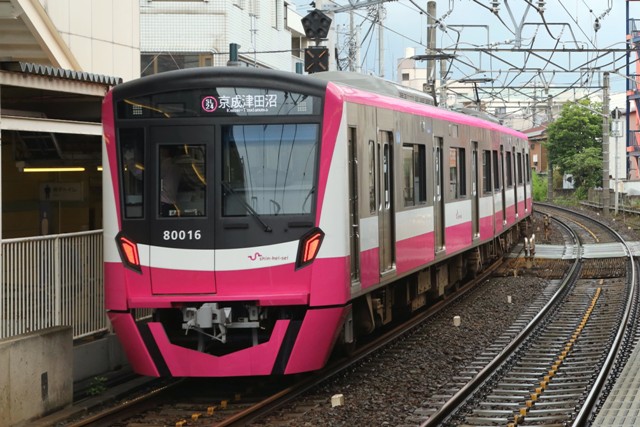Hokuso is a local railway company in Chiba Prefecture. It belongs to the Keisei Group. Keisei Electric Railway Company holds the majority of Hokuso's stock.
The EMU Hokuso 7300 series is one of the main fleets on the Hokuso line. It was launched in 1991, when the section between Keisei-Takasago and Shin-Kamagaya was inaugurated. Two sets, eight units, were built by Tokyu Sharyo and Nippon Sharyo. The 7300 series is a sister train of the Hokuso 7800 series, the Chiba Newtown Railway 9800 series and the Keisei 3700 series. In other words, these four models have basically the same technical specifications. They have stainless steel bodies with the same designs. They have a GTO-VVVF (GTO-variable frequency drive) inverter electric control system with 130kW induction motors.
The Hokuso 7300 series, 7800 series and the Chiba Newtown 9800 series are 8-car trains with four motorcars (6M2T); meanwhile, the Keisei 3700 series is a 6-car train with two motorcars (4M2T). The Hokuso 7300 series is their own rolling stock; meanwhile, the 7800 series is a rental train from Keisei Electric Railway.
Incidentally, Hokuso was established in 1972 for the carriage of the Chiba Newtown residents. The route extends to the western part of Chiba Prefecture including Chiba Newtown. Connecting Keisei-Takasago and Imba-Nihonidai stations, its route length is 32.3 kilometers including Chiba Newtown Railway line. The track is double and electrified. The gauge size is 1,435 millimeters. The electric system is 1,500 V overhead. Hokuso trains are directly operated onto the Keisei, Toei-Asakusa and Keikyu lines.
The EMU Hokuso 7300 series is one of the main fleets on the Hokuso line. It was launched in 1991, when the section between Keisei-Takasago and Shin-Kamagaya was inaugurated. Two sets, eight units, were built by Tokyu Sharyo and Nippon Sharyo. The 7300 series is a sister train of the Hokuso 7800 series, the Chiba Newtown Railway 9800 series and the Keisei 3700 series. In other words, these four models have basically the same technical specifications. They have stainless steel bodies with the same designs. They have a GTO-VVVF (GTO-variable frequency drive) inverter electric control system with 130kW induction motors.
The Hokuso 7300 series, 7800 series and the Chiba Newtown 9800 series are 8-car trains with four motorcars (6M2T); meanwhile, the Keisei 3700 series is a 6-car train with two motorcars (4M2T). The Hokuso 7300 series is their own rolling stock; meanwhile, the 7800 series is a rental train from Keisei Electric Railway.
Incidentally, Hokuso was established in 1972 for the carriage of the Chiba Newtown residents. The route extends to the western part of Chiba Prefecture including Chiba Newtown. Connecting Keisei-Takasago and Imba-Nihonidai stations, its route length is 32.3 kilometers including Chiba Newtown Railway line. The track is double and electrified. The gauge size is 1,435 millimeters. The electric system is 1,500 V overhead. Hokuso trains are directly operated onto the Keisei, Toei-Asakusa and Keikyu lines.

















